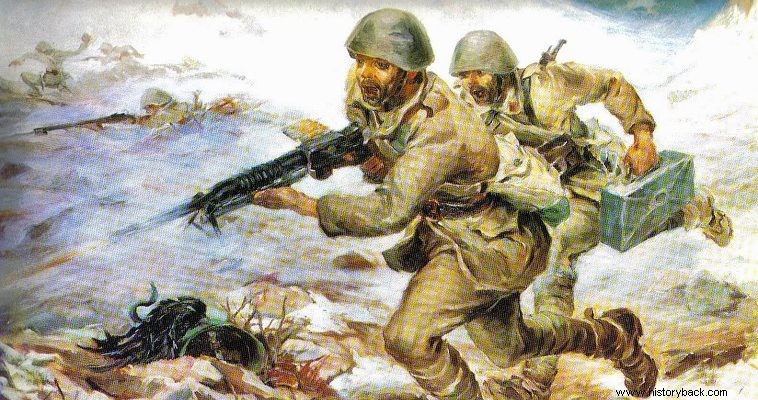
The nucleus of the Greek Infantry was, as in all armies, the battle group. However, the Greek battle group was relatively "large" numerically, in an attempt to complement the one machine gun it had with a sufficient number of rifles.
Each battle group was distinguished into two echelons, the machine gun half-team and the sniper half-team or maneuver half-team. The group was headed by the group sergeant.
Semigroups
The machine gun half team consisted of five men. It was headed by the corporal assistant team leader. The submachine gun, the main weapon of the combat team, was operated by the soldier marksman with the soldier loader as his immediate assistant. Two more supply soldiers completed the half team.
The sniper half-team consisted of seven men, the so-called first sniper - a corporal or the most experienced of the riflemen - five snipers and a soldier grenadier equipped with a rifle with a V.B. grenade launcher
The total strength of the battle group was 13 men. The team's armament consisted of two pistols for the shooter and loader, a submachine gun, seven rifles, three arabesques, a rifle with the ability to launch grenades and of course a submachine gun.
The battle group was the elementary subunit of the Infantry as it contained the two basic elements of Infantry power, fire and movement . The main task of the battle group was to use the machine gun as advantageously as possible to enable the semi-group to advance within striking distance of the enemy with the final objective of capturing enemy positions during the attack.
Also, the group could support with its fire the advance of another group, within the context of the familiar platoon, or move forward itself, supported by the fire of friendly groups.
Modes of energy
As the late Constantinos Davakis mentions in his 1938 "Engolpion of Infantry Officers", the combat team in the face of enemy resistance combines the energy of its means to neutralize or at least engage or immobilize the enemy.
In the event that its neighboring teams are stuck, the task of the team is to help the friendly teams in every way. In the event that it detects a gap in the enemy formation, its primary task is the bold penetration in depth until he meets the enemy and if it is easy to destroy him or at least hook him.
On defense a battle group was able to interdict a single axis of enemy advance. Depending on the tactical situation, the machine gun, which formed the core of the group's defensive arrangement, could be deployed at its edges, flanking the defensive location, or in its center, if the terrain was suitable, firing directly at the attacking opponent supported by the riflemen. The aggressively thrown front from the machine gun had a range of 50 m.
The platoon leader NCO had to have appropriate command experience. However, this was not a given in the Greek Army of the time and in no case did the Greek non-commissioned officer enjoy the initiative of his German equal, for example. On the contrary, it was the platoon officer who had to take control of the battle group charged with the main mission at the critical moment and lead it forward even by his personal example.
This tactic resulted in a disproportionately large number of casualties among junior officers in the Greek Army during the operations of 1940-41, but was entirely compatible with the aggressive spirit that prevailed in the Greek Infantry.
Formations
The battle group could deploy in man-by-man phalanx approach formation, in line and staggered to the right or left. During the approach, the sergeant group leader moved at the head of the group, followed by the corporal's assistant, at a distance of 5-10 m. Behind him followed the sniper with the machine gun and the other men of the semi-machine gun group. The gunners of the sniper semi-group followed, tailing the gunner. The distance between the two semi-groups was set at 15m. approx.
The group could be deployed in a line – in formation, according to the terminology of the time. This formation allowed the use of all its weapons, immediately. It could also be staggered to the right or left, with the squad leader and gunner at the top of the array and the gunner at the base.
However, the team could also be scaled in depth with the team leader, his assistant, the machine gunner and the first sniper, the loader and the suppliers in the first echelon, in the second echelon and the other men in the third. strong>
The combat team, just like today, approached the opponent with successive jumps performed either by half-groups, or by the entire group, or by men. The team leader gave the order "ready to jump", filling in "by team", "by half team" or "by man", as the case may be. The team leader also indicated the new positions to be occupied.
The team leader was responsible for his team's fire plan. He defined the targets that had to be hit in priority and determined the duration and volume of fire that had to be unleashed, i.e. shot by shot, burst shot of 6-8 rounds or even shot a whole film if he deemed it necessary.
The machine gun could theoretically open fire from distances of up to 1,000 m but was usually used at distances of 600 m and below. Fire from a walking position was carried out at distances of 300 m and below. Riflemen usually opened fire when within 400 m of the enemy. Depending on the situation the team leader could order fire at will.
The group's gunner opened fire with grenades at distances less than 200 m on the order of the group leader. Although underrated by some, the V.B. they were an important force multiplier for the Hellenic Army's infantry combat team in the absence of light mortars.
